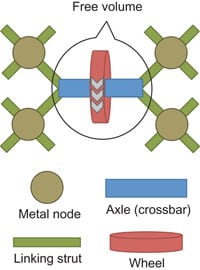
Canadian chemists have induced a metal-organic framework to self-assemble and function as a molecular wheel on an axle in a solid state material. From a University of Windsor news article “Chemists break new ground in molecular machine research“:
A graduate student and his team of researchers have turned the chemistry world on its ear by becoming the first ever to prove that tiny interlocked molecules can function inside solid materials, laying the important groundwork for the future creation of molecular machines.
“Until now, this has only ever been done in solution,” explained Chemistry & Biochemistry PhD student Nick Vukotic, lead author on a front page article recently published in the June issue of the journal Nature Chemistry [abstract]. “We’re the first ones to put this into a solid state material.”
The material Vukotic is referring to is UWDM-1, or University of Windsor Dynamic Material, a powdery substance that the team made which contains rotaxane molecules and binuclear copper centers. The rotaxane molecules, which resemble a wheel around the outside of an axle, were synthesised in their lab. The group found that heating of these rotaxane molecules with a copper source resulted in the formation of a crystalline material which contained structured arrangement of the rotaxane molecules, spaced out by the binuclear copper centers.
“Basically, they self-assemble in to this arrangement,” said Vukotic, who works under the tutelage of chemistry professor Steve Loeb. Other team members include professor Rob Schurko, and post-doctoral fellows Kristopher Harris and Kelong Zhu.
Heating the material causes the wheels to rapidly rotate around the axles, while cooling the material causes the wheels to stop, he said. The entire process can’t be viewed with a microscope, so the motion was confirmed in Dr. Schurko’s lab using a process called nuclear magnetic resonance spectroscopy.
“You can actually measure the motion and you can do it unambiguously by placing an isotopic tag on the ring,” explained Dr. Harris, who helped oversee that verification process.
Although the team admits their findings are still very much a proof of principle, they insist that molecules in solid materials can be manipulated to form switches and machines. This could be extremely significant and could find future applications in the fields of computer storage, data transfer or controlling the electronic properties of materials at the molecular level. …
A key component of exploratory engineering studies for molecular manufacturing or productive nanosystems is the ability to model molecular systems reliably. Modeling motions of molecules in solution is very difficult. A method to produce molecular machines in a solid state environment is a huge step forward. It will be interesting to see just how complex a system of machines can be built in the solid state using these methods, and what can be done with them.
—James Lewis, PhD


